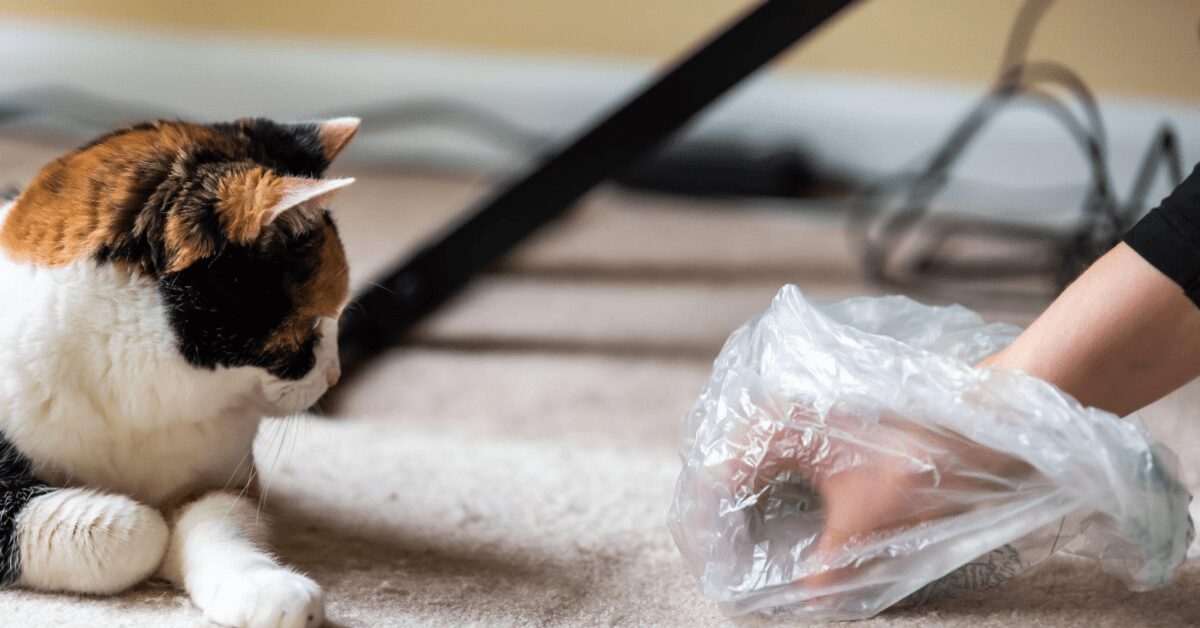Key Points
- Cats occasionally have trouble bringing up hairballs and may need help passing them.
- Diet changes, increasing exercise, ensuring proper hydration of your cat or adding fish oils or cat hairball gels can reduce the formation of hairballs.
- If your cat suffers from frequent hairballs or blockages, a visit to the vet may be in the cards.
Most cats get hairballs occasionally, but some cats need extra help to pass them. A hairball remedy may be necessary if your cat is coughing and gagging but not producing a hairball.
Hairball remedies can be as simple as putting a bit of petroleum jelly on your cat’s paws to lick or adding a hairball gel to their daily diet. Oils, gels, or pastes made specifically for cats lubricate the digestive tract or may work as a laxative to allow the hairball to pass more quickly.
There are things you can do at home inexpensively to help your cat pass a stubborn hairball. However, it’s also important to know when it’s time to see the veterinarian, as problems with hairballs can mimic other medical conditions.
What is the best way to help your cat pass a hairball?
Most cats will process their food quickly enough to allow undigestible hair to pass through their digestive tract. But sometimes, fur can stay in the cat’s stomach too long, form a clump that won’t pass, and the cat vomits it up. Less commonly, the clump can become large enough to create a blockage.
Fortunately, there are simple ways to reduce the production of hairballs (even for over-groomers!) and provide quick relief.
Digestive lubricants
Add a hairball gel or paste to your cat’s food, or put a dollop on their paws. They will lick enough to lubricate their digestion system, allowing the hairball to pass. Petroleum jelly is another choice and also works as a mild laxative. You may need to give more than one application before they work. Always talk to your vet about any product you plan to offer your cat.
Feline stool softeners and laxatives
These products help when the hair has reached the intestines. If your cat has constipation or is straining to poop, a laxative or stool softener may provide quick relief. Again, always talk to your vet about any product you plan to offer your cat.
Herbs and supplements
Digestive supplements with enzymes and probiotics can help your cat’s digestive system pass hairballs. Herbs like marshmallow root, slippery elm, or licorice lubricate the intestinal tract, reduce inflammation, and improve your cat’s coat. These remedies may help in the long term for cats with frequent hairballs.
Cat grass or malty treats
A high-fiber malty hairball treat or a few nibbles of cat grass can add enough fiber to your cat’s stool to help hairballs pass through the digestive tract.
How to naturally reduce hairballs in cats
Brush their fur regularly
Brushing regularly pulls loose hair from fur that would otherwise be swallowed. Long-haired cats do best with daily brushing, and many short-haired cats enjoy being brushed a couple times a week.
Add some changes to their diet
Dietary changes can also help reduce hairball production. This might look like:
- Smaller, more frequent meals
- High-fiber dry kibble for cats with a regular dry food diet. Many dry cat foods that reduce hairballs contain pea fiber, psyllium, cellulose, pectin, rice hulls, or beet pulp to add extra fiber to help pull the hair through the digestive system.
- Feeding wet food: Canned or wet cat food provides a higher moisture content that helps with hydration to keep the digestive tract lubricated and moving. Adding water to dry kibble can help hydrate cats on exclusive dry diets.
- Add oils to your cat’s diet. Fish oil, olive oil, and coconut oil can help hairballs pass by lubricating the digestive tract. Fish oil is ideal because of the Omega-3 fats they contain.
Increase hydration
Proper hydration allows the food and hair to move through the digestive tract efficiently. Cats on dry kibble may not get the hydration they need, which can slow down the digestive process and allow hair to clump in the stomach. Add water to dry kibble to keep your cat hydrated.
Using a water fountain, or placing several water bowls around, encourages cats to drink more water. Putting salt-free broth in the water will encourage some cats to drink more often. Just remember to keep the bowls and fountain very clean to discourage bacterial growth.
Increase exercise
An increase in exercise or play will keep the digestive tract toned and contracting properly. Regular exercise is important for maintaining your cat’s health.
Add fiber to their food
Pumpkin, sweet potato, or cut cat grass adds fiber to your cat’s diet to pull the hair through the digestive tract.
Reduce stress
Some cats over-groom themselves in response to pain or stress. Licking themselves too often causes them to swallow excessive amounts of hair. Reducing stress and ensuring your cat is not in pain can reduce over-grooming habits.
Why do cats get hairballs?
During grooming, swallowed fur travels down the cat’s throat to the stomach and blends with bile and digestive liquids. Most of the fur travels through the gastrointestinal tract to be incorporated into your cat’s feces and deposited in the litter box. However, some hair can remain in the stomach and form a trichobezoar (hairball) clump.
As the clump grows, it becomes too large to pass through the digestive tract, leaving the cat to throw it up to get rid of it. If a hairball becomes too large or remains in the stomach too long, it can mineralize and become hard or too large to pass. This can cause constipation or an intestinal blockage that may require surgery to remove – a serious health risk to your cat.
How often do cats pass hairballs?
Most cats will throw up a hairball once or twice a month. If it happens more frequently, your cat may have a hairball problem.
What causes frequent hairballs?
Cats who over-groom, shedding season (spring and fall), and life changes that cause undue stress can all increase hairballs. If a cat is older, ill, has arthritis pain, or a chronic disease, lack of grooming may also increase the formation of hairballs. Digestive tract issues may also hinder fur passage through the intestines, leaving it in the stomach to form a hairball.
How will I know when my cat needs to see the vet?
If your cat is throwing up frequently, either food or fluid, your cat should see their veterinarian to ensure there are no health issues.
Symptoms to watch for:
- Prolonged gagging, hacking, or vomiting that is unproductive
- Frequently throwing up fluid or food
- Loss or drop in appetite
- Weight loss
- Constipation or diarrhea
- Excessive grass nibbling trying to calm stomach upset
- Lethargy
- Swollen or tender abdomen
How will I know my cat is trying to throw up a hairball and not just coughing?
When your cat needs to get rid of a hairball, you’ll notice them coughing, hacking, or retching with their head lowered and their neck stretched. Recurrent coughing with no hairball produced could signify a health condition requiring veterinary care.
How long should it take to pass a hairball?
Cats throw up hairballs in a few minutes. If your cat is gagging or retching longer than that, there may be a blockage in the esophagus or intestines. Symptoms of a blockage:
- Repeated vomiting and/or gagging
- Lethargy
- Appetite loss
As gross as hairballs can be, and as much as we dislike finding them on our floors or furniture, many cats get them. Fortunately, there are simple ways to reduce the production of hairballs, even for over-groomers, making your cat more comfortable in the long run.




